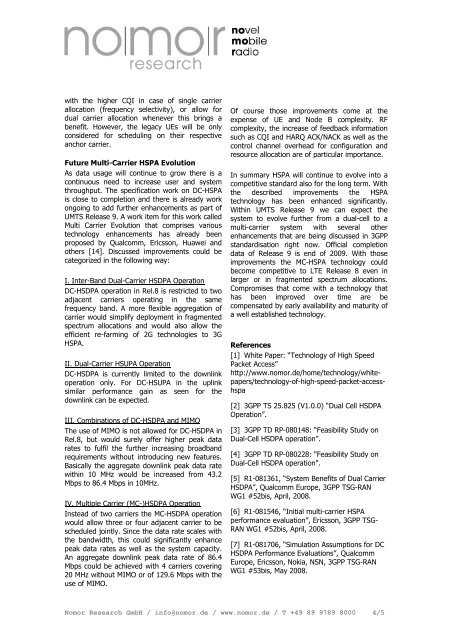White Paper – Dual Cell HSDPA and its Future ... - Nomor Research
White Paper – Dual Cell HSDPA and its Future ... - Nomor Research
White Paper – Dual Cell HSDPA and its Future ... - Nomor Research
You also want an ePaper? Increase the reach of your titles
YUMPU automatically turns print PDFs into web optimized ePapers that Google loves.
with the higher CQI in case of single carrier<br />
allocation (frequency selectivity), or allow for<br />
dual carrier allocation whenever this brings a<br />
benefit. However, the legacy UEs will be only<br />
considered for scheduling on their respective<br />
anchor carrier.<br />
<strong>Future</strong> Multi-Carrier HSPA Evolution<br />
As data usage will continue to grow there is a<br />
continuous need to increase user <strong>and</strong> system<br />
throughput. The specification work on DC-HSPA<br />
is close to completion <strong>and</strong> there is already work<br />
ongoing to add further enhancements as part of<br />
UMTS Release 9. A work item for this work called<br />
Multi Carrier Evolution that comprises various<br />
technology enhancements has already been<br />
proposed by Qualcomm, Ericsson, Huawei <strong>and</strong><br />
others [14]. Discussed improvements could be<br />
categorized in the following way:<br />
I. Inter-B<strong>and</strong> <strong>Dual</strong>-Carrier <strong>HSDPA</strong> Operation<br />
DC-<strong>HSDPA</strong> operation in Rel.8 is restricted to two<br />
adjacent carriers operating in the same<br />
frequency b<strong>and</strong>. A more flexible aggregation of<br />
carrier would simplify deployment in fragmented<br />
spectrum allocations <strong>and</strong> would also allow the<br />
efficient re-farming of 2G technologies to 3G<br />
HSPA.<br />
II. <strong>Dual</strong>-Carrier HSUPA Operation<br />
DC-<strong>HSDPA</strong> is currently limited to the downlink<br />
operation only. For DC-HSUPA in the uplink<br />
similar performance gain as seen for the<br />
downlink can be expected.<br />
III. Combinations of DC-<strong>HSDPA</strong> <strong>and</strong> MIMO<br />
The use of MIMO is not allowed for DC-<strong>HSDPA</strong> in<br />
Rel.8, but would surely offer higher peak data<br />
rates to fulfil the further increasing broadb<strong>and</strong><br />
requirements without introducing new features.<br />
Basically the aggregate downlink peak data rate<br />
within 10 MHz would be increased from 43.2<br />
Mbps to 86.4 Mbps in 10MHz.<br />
IV. Multiple Carrier (MC-)<strong>HSDPA</strong> Operation<br />
Instead of two carriers the MC-<strong>HSDPA</strong> operation<br />
would allow three or four adjacent carrier to be<br />
scheduled jointly. Since the data rate scales with<br />
the b<strong>and</strong>width, this could significantly enhance<br />
peak data rates as well as the system capacity.<br />
An aggregate downlink peak data rate of 86.4<br />
Mbps could be achieved with 4 carriers covering<br />
20 MHz without MIMO or of 129.6 Mbps with the<br />
use of MIMO.<br />
Of course those improvements come at the<br />
expense of UE <strong>and</strong> Node B complexity. RF<br />
complexity, the increase of feedback information<br />
such as CQI <strong>and</strong> HARQ ACK/NACK as well as the<br />
control channel overhead for configuration <strong>and</strong><br />
resource allocation are of particular importance.<br />
In summary HSPA will continue to evolve into a<br />
competitive st<strong>and</strong>ard also for the long term. With<br />
the described improvements the HSPA<br />
technology has been enhanced significantly.<br />
Within UMTS Release 9 we can expect the<br />
system to evolve further from a dual-cell to a<br />
multi-carrier system with several other<br />
enhancements that are being discussed in 3GPP<br />
st<strong>and</strong>ardisation right now. Official completion<br />
data of Release 9 is end of 2009. With those<br />
improvements the MC-HSPA technology could<br />
become competitive to LTE Release 8 even in<br />
larger or in fragmented spectrum allocations.<br />
Compromises that come with a technology that<br />
has been improved over time are be<br />
compensated by early availability <strong>and</strong> maturity of<br />
a well established technology.<br />
References<br />
[1] <strong>White</strong> <strong>Paper</strong>: “Technology of High Speed<br />
Packet Access”<br />
http://www.nomor.de/home/technology/whitepapers/technology-of-high-speed-packet-accesshspa<br />
[2] 3GPP TS 25.825 (V1.0.0) “<strong>Dual</strong> <strong>Cell</strong> <strong>HSDPA</strong><br />
Operation”.<br />
[3] 3GPP TD RP-080148: “Feasibility Study on<br />
<strong>Dual</strong>-<strong>Cell</strong> <strong>HSDPA</strong> operation”.<br />
[4] 3GPP TD RP-080228: "Feasibility Study on<br />
<strong>Dual</strong>-<strong>Cell</strong> <strong>HSDPA</strong> operation".<br />
[5] R1-081361, “System Benef<strong>its</strong> of <strong>Dual</strong> Carrier<br />
<strong>HSDPA</strong>”, Qualcomm Europe, 3GPP TSG-RAN<br />
WG1 #52bis, April, 2008.<br />
[6] R1-081546, “Initial multi-carrier HSPA<br />
performance evaluation”, Ericsson, 3GPP TSG-<br />
RAN WG1 #52bis, April, 2008.<br />
[7] R1-081706, “Simulation Assumptions for DC<br />
<strong>HSDPA</strong> Performance Evaluations”, Qualcomm<br />
Europe, Ericsson, Nokia, NSN, 3GPP TSG-RAN<br />
WG1 #53bis, May 2008.<br />
<strong>Nomor</strong> <strong>Research</strong> GmbH / info@nomor.de / www.nomor.de / T +49 89 9789 8000 4/5


